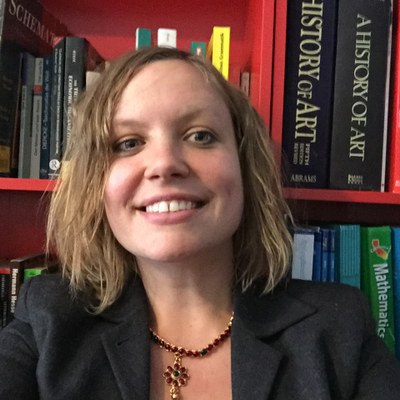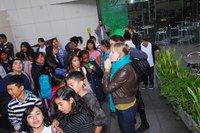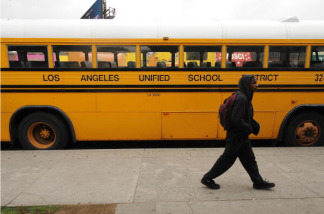Julie Van Winkle's Portfolio Homepage
Autobiographical Statement
 I am a public school teacher in Los Angeles, and I believe it is my duty – and the duty of everyone who works in education – to ensure that every student, regardless of race, gender or socio-economic status – has the opportunity to empower her/himself through education.
I am a public school teacher in Los Angeles, and I believe it is my duty – and the duty of everyone who works in education – to ensure that every student, regardless of race, gender or socio-economic status – has the opportunity to empower her/himself through education.
After obtaining my Bachelors Degree from UCLA in 2003, I became a University Intern at UCLA, teaching at a middle school in South LA while completing the coursework to finish my teaching credential. I decided to pursue a career in teaching because I thought it would give me the opportunity to teach English in other countries; however, after seeing first-hand the challenges that face students, teachers, and school leaders here in Los Angeles, I decided that I wanted to devote my career to improving the public education system in Los Angeles.
 My first year of teaching in 2004 began mid-way through the academic year: I was taking over a 6th grade class that had had no teacher (just period-by-period coverage) for most of the first semester. Being a first-year teacher with no experience or prior training was the most humbling experience I have ever had. Although I knew that my students were living in poverty and that many of them were English learners, I didn’t fully understand the institutional challenges that they faced, or for example how a standardized test like the CST could be biased against certain groups of students. One question on the end of year CST Exam asked students needed how many planks a pier would have if it extended a certain number of feet into the ocean. None of my 40 students knew what a pier or a plank was, and when I told them, “C’mon, everbody – I’m sure you’ve seen one when you went to the beach” (which was less than ten miles from the school). However, I was shocked to learn that none of them had ever been to the beach.
My first year of teaching in 2004 began mid-way through the academic year: I was taking over a 6th grade class that had had no teacher (just period-by-period coverage) for most of the first semester. Being a first-year teacher with no experience or prior training was the most humbling experience I have ever had. Although I knew that my students were living in poverty and that many of them were English learners, I didn’t fully understand the institutional challenges that they faced, or for example how a standardized test like the CST could be biased against certain groups of students. One question on the end of year CST Exam asked students needed how many planks a pier would have if it extended a certain number of feet into the ocean. None of my 40 students knew what a pier or a plank was, and when I told them, “C’mon, everbody – I’m sure you’ve seen one when you went to the beach” (which was less than ten miles from the school). However, I was shocked to learn that none of them had ever been to the beach.
All of the sudden, I realized how these tests were biased. Aside from knowing the content and being able to read English well enough to understand the question, my students had the disadvantage of having a life experience that differs from the white, middle-class “standard.” In the context of American culture, middle- and upper-class children have a wider range of prior experience (more cultural capital) to draw upon, and thus the questions on standardized tests are biased toward the students who are able to relate to the question’s context. At that moment, my personal philosophy of education changed: I no longer saw my duty as a teacher as a transmitter of knowledge, but rather as an advocate for my students. I wanted my students to think about their current place in our culture, and to challenge the status-quo by empowering themselves and making their voices heard.
 Since that first year, I continued to work in schools that served low-income, majority-Latino communities in Los Angeles. I have worked in a charter school and a school co-located by a charter, I was one of the founding staff members of a newly-opened district school, and I have worked in schools that are over a century old. I have been RIF’ed and displaced, I have been forced to sub in my own teaching position, and I have spent weeks of my teaching career camping out on the pavement in front of my school and the District headquarters with other teachers, parents, and community members demanding stability for inner-city schools. I have lead teams of teachers to work on developing inquiry-based, constuctivist curricula that allow more entry-points for students of diverse academic backgrounds. My current position, Secondary Math Common Core Facilitator, is outside of the classroom, and I work with several high schools to help Math teachers transition to the Common Core State Standards.
Since that first year, I continued to work in schools that served low-income, majority-Latino communities in Los Angeles. I have worked in a charter school and a school co-located by a charter, I was one of the founding staff members of a newly-opened district school, and I have worked in schools that are over a century old. I have been RIF’ed and displaced, I have been forced to sub in my own teaching position, and I have spent weeks of my teaching career camping out on the pavement in front of my school and the District headquarters with other teachers, parents, and community members demanding stability for inner-city schools. I have lead teams of teachers to work on developing inquiry-based, constuctivist curricula that allow more entry-points for students of diverse academic backgrounds. My current position, Secondary Math Common Core Facilitator, is outside of the classroom, and I work with several high schools to help Math teachers transition to the Common Core State Standards.
District Context
I work for the Los Angeles Unified School District, the second-largest district in the United States. About three-fourths of LAUSD students are Latino, and the majority of LAUSD students qualify for Title 1 funding. LAUSD has a reputation for extremely overcrowded schools, excessive bureaucracy, poor maintenance of facilities, high drop-out rates, and low academic performance. The leadership changes frequently, and the schools and local districts have been reorganized on a fairly regular basis.

My teaching career has been a patchwork of different experiences at many school sites due to budget cuts and teacher layoffs, but it has taught me much about teaching and learning at a school site and district-wide, and about the systematic inequities that exist not only within our district, but across our whole nation. As I continue my career in education, my goal is to change public schools to reflect the experiences and values of the students they serve.

